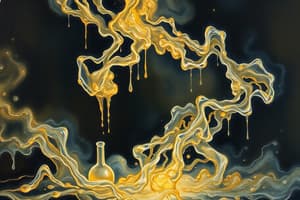Podcast
Questions and Answers
What is the primary characteristic of a chemical reaction?
What is the primary characteristic of a chemical reaction?
- The formation of only one product
- The absorption of heat energy
- The transformation of atoms or molecules (correct)
- The release of light energy
What type of chemical reaction involves the combination of two or more substances to form a new substance?
What type of chemical reaction involves the combination of two or more substances to form a new substance?
- Single displacement reaction
- Synthesis reaction (correct)
- Double displacement reaction
- Decomposition reaction
What is the purpose of balancing a chemical equation?
What is the purpose of balancing a chemical equation?
- To calculate the amount of heat energy released
- To ensure that the number of atoms of each element is the same on both the reactant and product sides (correct)
- To determine the type of reaction occurring
- To make the equation look more aesthetically pleasing
What symbol is used to indicate the direction of a chemical reaction?
What symbol is used to indicate the direction of a chemical reaction?
What is the term for the study of the quantitative relationships between reactants and products in a chemical reaction?
What is the term for the study of the quantitative relationships between reactants and products in a chemical reaction?
What is added to balance a chemical equation, if necessary?
What is added to balance a chemical equation, if necessary?
What is the purpose of using state symbols in a chemical equation?
What is the purpose of using state symbols in a chemical equation?
What is used to determine the amounts of reactants required or products formed in a reaction?
What is used to determine the amounts of reactants required or products formed in a reaction?
Flashcards are hidden until you start studying
Study Notes
Chemical Reactions
- A chemical reaction is a process in which one or more substances (reactants) are converted into new substances (products)
- Chemical reactions involve the transformation of atoms or molecules, resulting in a change in the chemical composition of the substances involved
Types of Chemical Reactions
- Synthesis reaction: two or more substances combine to form a new substance
- Example: 2H2 + O2 → 2H2O
- Decomposition reaction: a single substance breaks down into two or more simpler substances
- Example: 2H2O → 2H2 + O2
- Single displacement reaction: one element displaces another element from a compound
- Example: Zn + CuSO4 → ZnSO4 + Cu
- Double displacement reaction: two compounds exchange partners, resulting in the formation of two new compounds
- Example: NaCl + AgNO3 → NaNO3 + AgCl
Chemical Equations
- A chemical equation is a symbolic representation of a chemical reaction, using chemical formulas and symbols to represent the reactants and products
- Chemical equations must be balanced, meaning that the number of atoms of each element is the same on both the reactant and product sides
Writing Chemical Equations
- Use chemical formulas to represent the reactants and products
- Use arrows to indicate the direction of the reaction (→)
- Use coefficients to balance the equation, if necessary
- Write the reactants on the left side of the arrow and the products on the right side
- Use state symbols to indicate the physical state of the substances (s, l, g, aq)
Balancing Chemical Equations
- Count the number of atoms of each element on both the reactant and product sides
- Add coefficients to balance the equation, if necessary
- Check to ensure that the equation is balanced by counting the number of atoms of each element on both sides
Stoichiometry
- Stoichiometry is the study of the quantitative relationships between reactants and products in a chemical reaction
- Mole ratios can be used to determine the amounts of reactants required or products formed in a reaction
Chemical Reactions
- Chemical reactions involve the transformation of atoms or molecules, resulting in a change in the chemical composition of the substances involved
- Reactants are converted into new substances, known as products
Types of Chemical Reactions
- Synthesis reaction: combines two or more substances to form a new substance, e.g., 2H2 + O2 → 2H2O
- Decomposition reaction: breaks down a single substance into two or more simpler substances, e.g., 2H2O → 2H2 + O2
- Single displacement reaction: one element displaces another element from a compound, e.g., Zn + CuSO4 → ZnSO4 + Cu
- Double displacement reaction: two compounds exchange partners, resulting in the formation of two new compounds, e.g., NaCl + AgNO3 → NaNO3 + AgCl
Chemical Equations
- A chemical equation is a symbolic representation of a chemical reaction, using chemical formulas and symbols
- Chemical equations must be balanced, meaning that the number of atoms of each element is the same on both the reactant and product sides
Writing Chemical Equations
- Use chemical formulas to represent reactants and products
- Use arrows to indicate the direction of the reaction (→)
- Use coefficients to balance the equation, if necessary
- Reactants are written on the left side of the arrow, and products on the right side
- Use state symbols to indicate the physical state of substances (s, l, g, aq)
Balancing Chemical Equations
- Count the number of atoms of each element on both reactant and product sides
- Add coefficients to balance the equation, if necessary
- Ensure the equation is balanced by counting the number of atoms of each element on both sides
Stoichiometry
- Stoichiometry is the study of quantitative relationships between reactants and products in a chemical reaction
- Mole ratios can be used to determine the amounts of reactants required or products formed in a reaction
Studying That Suits You
Use AI to generate personalized quizzes and flashcards to suit your learning preferences.




